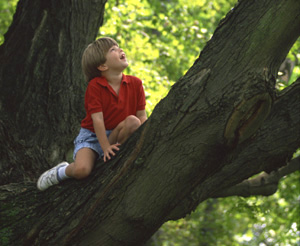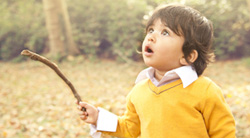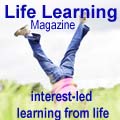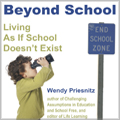 |
All at once, my daughter has developed a fascination with tree-climbing. A few weeks ago, we were playing in this wonderful little grove of trees near the house, and she just started going up. Now, she’s unstoppable. Even when she’s riding in the car, she’s scoping out the trees as we pass: “That looks like a good one to climb; we’ll have to come back to that tree.” As a Nature educator, I’m a big fan of trees over plastic play equipment. Let’s just compare plastic play equipment, such as you might find at your local neighborhood park, with trees and rocks. Balance Your typical “jungle gym” apparatus at a park offers basically one way to go up or down. You use the ladder, or the fake rock-climbing bumps. There is a “right way” (i.e. one way that gets you to the top) and all the other ways – which don’t get you to the top of the structure, where the other “experiences” await. The rungs on the ladder, the bars, are all the exact same size and dimension. And there is only one place to go. One outcome: reach the top. A tree on the other hand, offers a variety of ways to get from one place to another. Reaching the “top” is usually not the goal. (Although for some kids, it certainly might be.) There are exciting and interesting things to be found in all sorts of places within the branches of a tree. Tree branches differ wildly in size, shape, strength and texture. This offers great physical challenges and requires the development of balance well beyond what a series of uniform metal bars offers. It also requires coordination and concentration. Creativity There is usually only one thing to do with plastic playground equipment. You climb to the top of something, you slide down. You swing. Plastic play equipment is great for letting off steam. Kids love to climb, slide, and swing. Mine are no exception. But it is rather one-sided, kind of a “flat” experience. Go to any playground, there’s just not much variation in the way kids play. Get out in Nature, on the other hand, and something else happens. Kids use their imaginations more freely when playing in Nature: “Hmm, here’s a great big tree. What can I do here? I can climb it, bounce on the low limbs, swing from the branches, hide in the boughs.” “Here are some huge rocks – I can jump from them, crawl, lie on my belly, lean against them.” With no pieces of equipment directing how kids play, they can be free to make up their own rules and set their own goals for play. Safety All that aside, it’s at times challenging as a mom to let my kids climb trees, jump off boulders, and the like. Occasionally, one of them will jump off something kinda high, “land wrong” and get a minor owie. And sometimes they go really high. Out of my reach. And there are often rocks and roots and other hard, sharp things on the ground beneath them. And what if she falls and hits a branch on her way down? Or, what if he falls off that boulder and cuts his head open? When these thoughts creep in – and believe me, they do – I really try to see it as a chance for me to work on my own balance and strength. (Frankly, I’ve got the “creativity” part down; I can think of a million what-ifs for any given situation). The thing is, I’ve got to let them do this. I really believe this is important. It’s good for them in a way that nothing else is. And, really, what are the chances of one of these random bad things actually happening? Extremely, extremely small. Is it any less likely that something bad will happen on a playground? Probably…more likely, actually. So, I take a deep breath. I lift him to a bough he can hang from. I give her a boost up to that next branch. And I stand there, under the tree, and we all grow. Risk Assessment The kids and I spent a glorious morning over the weekend leading a “Nature playgroup” at a wonderful and underappreciated gem of an urban park. (One of my most delightful jobs is to lead these Nature playdates for families with children...we get out and explore the urban park system and generally have fun just messing around in natural areas.) J and L (and about fifteen other kids!) were frolicking in the sunshine, picking up leaves and tossing them high into the air. We were all on a hill that was dotted with huge, sprawling oak trees. There were sticks and acorns everywhere. J immediately found a stick about six inches long, as big around as, oh, I don’t know, Barbie’s leg. He didn’t want to put it down. He was carrying it around under his arm, holding it like a walking stick, even cuddling with it at one point. And in his exuberance, he was running and jumping.
I wasn’t going to be “that parent” who won’t let her kids play with sticks (and who am I kidding? I’m not that parent). But then again, it did cross my mind that, well, he was running with a stick. I actually had an entire internal dialogue about this: Should I put a stop to this? No, he’s fine, he’s having fun. Let him enjoy it. What’s the problem? Relax, I told myself. You worry too much. A wisp of anxiety floated through my mind...well, he could get hurt, couldn’t he? But really, what are the chances that he’ll actually poke his eye out? Well, wouldn’t you know. The moment I had that awful thought, J fell down. Onto the stick. Luckily, it didn’t actually enter his eye, but it came darn close. For a few moments there, I felt like The Worst Mother in the World. I mean, I let the kid run with a stick on wet leaves: OK, not the best choice. So. The corner of his right eye is bruised, swollen, and scratched. He cried for a long time, but was okay. No real harm done. In fact, he’s a little proud to tell the story to anyone who’ll listen. I’ve heard lots of reasons for parents and educators not wanting kids to play with sticks, and injury is top among them. But it’s often there that people stop. Well, okay, I ask them, so what if there was an injury? Would that be OK? Or not? Is the risk worth the benefit? How bad would it be? When it comes to playing outside, many parents ry to eliminate the possibility of any injuries altogether. How can you mitigate every possible risk? I don’t think this is realistic, or even possible. I’m certainly not saying I think injuries are good, and I’m not trying to minimize real risk and real injury. I’m just saying that sometimes minor injuries aren’t necessarily as bad as we imagine them. The risk of getting poked with a stick is, to me, not high or bad enough to warrant removing sticks from my child’s repertoire of playthings. And isn’t that how it is with most risks involved in outdoor play? There is often a considerable risk of some relatively minor injury and a much, much smaller risk of something much, much worse. So, when do we refuse to let them have the experience because of the small risk that Something Really Bad will happen? Now granted, I recognize J was darn lucky this weekend. It could have been really bad. But it wasn’t. And most of the time, thank goodness, it just isn’t. Patty Born Selly is the founder of Small Wonders, an educational consulting company that provides teacher training and support for science and Nature education initiatives. Patty also is an adjunct faculty member at Hamline University and Metropolitan State University in Minnesota, where she teaches classes on Nature and environmental education, as well as science education, to early childhood and elementary school teachers. She has taught preschoolers, kindergartners, and elementary school students. Patty holds a master’s degree in education. She is the author of “Early Childhood Activities for a Greener Earth” and “Common Bonds: Why Children Need Animals.”
| |







